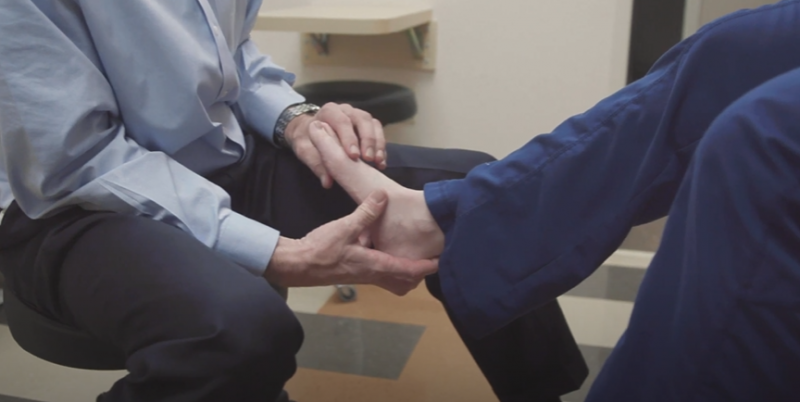
WHAT IS PLANTAR FASCIITIS?
Plantar fasciitis is the most common cause of foot pain, radiating from the bottom of the heel throughout the foot. The plantar fascia is the strong band of tissue in the arch of your foot, which runs from your heel to toe and absorbs strains and stress placed on the foot each time it is in use. Plantar fasciitis occurs when that supporting tissue becomes irritated and inflamed. Signs of plantar fasciitis include heel pain, pain with first initial steps after rest, and pain with extended exercise.
About 90% of plantar fasciitis cases heal successfully with conservative treatment options, but the longer it goes unaddressed, the longer it will take to heal and more complications can arise.
Symptoms of Plantar fasciitis
The symptoms of plantar fasciitis typically develop gradually over time and may include sharp or stabbing pain in the heel, especially with the first steps in the morning or after prolonged periods of sitting or standing. The pain may also worsen after physical activity. The bottom of the foot may feel tender or inflamed, and the arch of the foot may feel tight or stiff.
In some cases, swelling may be present in the heel or arch. The pain and discomfort associated with plantar fasciitis can interfere with daily activities and make it difficult to exercise or walk for extended periods of time. It is important to seek medical attention if symptoms persist or worsen over time. Early treatment can help reduce pain and prevent further damage to the plantar fascia.
RISKS OF UNTREATED PLANTAR FASCIITIS:
Plantar ruptures: Plantar ruptures can happen if plantar fasciitis is not addressed and you continue to place heavy impacts on the plantar fascia. These activities include running, sports, or even standing for long periods of time.
You likely have ruptured your plantar fascia if you hear a loud popping noise followed by intense pain, bruising, and swelling in the foot. If you believe you have ruptured your plantar fascia, seek medical help immediately. You may be required to wear a boot or use crutches for a period of time.
Plantar tears: When plantar fasciitis is left untreated, the plantar fascia can become inflamed and cause small micro tears. Many don’t notice these small tears as they arise until the pain becomes gradually worse. If left untreated, these tears can grow in size and numbers, causing further complications.
Heel Spurs: Heel spurs are a common response to plantar fasciitis left untreated. In order to protect the arch of your foot from damage, your body generates calcium. Over time, these calcium deposits create sharp protrusions that push against the fatty part of the heel causing pain with each step. Heel spurs can often be avoided if treated early.
Plantar Fibromatosis: Plantar Fibromatosis is a condition where benign nodules grow slowly along the plantar fascia. These often are undetected in the early stages until they suddenly begin to grow more rapidly. Over time as the nodules continue to grow, walking may become painful and uncomfortable.
If you’re suffering from plantar fasciitis pain visit one of our foot and ankle specialists for treatment.
Treatments for Plantar Fasciitis
The treatment for plantar fasciitis is aimed at reducing heel pain, inflammation, and improving the flexibility of the plantar fascia. The treatment options for plantar fasciitis may include rest, ice, compression, and elevation (RICE) therapy to reduce swelling and pain. Over-the-counter pain medications such as acetaminophen or ibuprofen may also provide relief.
Stretching exercises and physical therapy helps to improve flexibility and strength in the plantar fascia and surrounding muscles. Orthotic shoe inserts or heel cups may be recommended to provide additional support and cushioning for the foot. Surgery is typically a last resort and is only considered in severe cases that do not respond to other treatments. It is important to seek medical attention from a foot and ankle specialist early to receive a proper diagnosis and develop an appropriate treatment plan that addresses the patient’s specific needs.
In this quick video, foot and ankle specialist, Dr. Anthony Hinz, explains his treatment for plantar fasciitis.
Keep up to date on future webinars and events and receive information on living a healthy and pain free life from our providers by joining our monthly newsletter. Click below to sign up!





